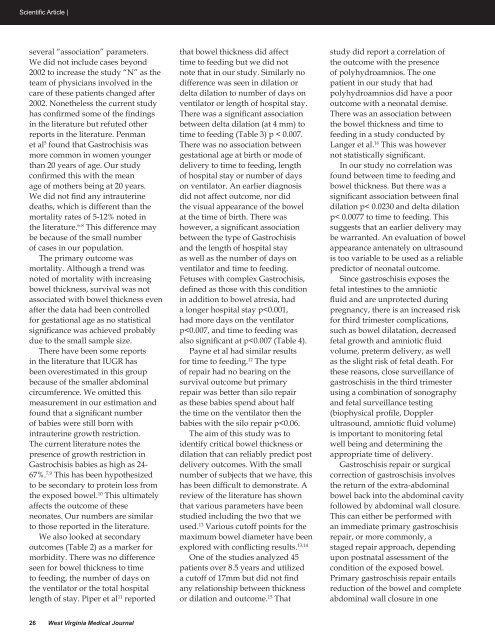March/April - West Virginia State Medical Association
March/April - West Virginia State Medical Association
March/April - West Virginia State Medical Association
Create successful ePaper yourself
Turn your PDF publications into a flip-book with our unique Google optimized e-Paper software.
Scientific Article |<br />
several “association” parameters.<br />
We did not include cases beyond<br />
2002 to increase the study “N” as the<br />
team of physicians involved in the<br />
care of these patients changed after<br />
2002. Nonetheless the current study<br />
has confirmed some of the findings<br />
in the literature but refuted other<br />
reports in the literature. Penman<br />
et al 5 found that Gastrochisis was<br />
more common in women younger<br />
than 20 years of age. Our study<br />
confirmed this with the mean<br />
age of mothers being at 20 years.<br />
We did not find any intrauterine<br />
deaths, which is different than the<br />
mortality rates of 5-12% noted in<br />
the literature. 6-8 This difference may<br />
be because of the small number<br />
of cases in our population.<br />
The primary outcome was<br />
mortality. Although a trend was<br />
noted of mortality with increasing<br />
bowel thickness, survival was not<br />
associated with bowel thickness even<br />
after the data had been controlled<br />
for gestational age as no statistical<br />
significance was achieved probably<br />
due to the small sample size.<br />
There have been some reports<br />
in the literature that IUGR has<br />
been overestimated in this group<br />
because of the smaller abdominal<br />
circumference. We omitted this<br />
measurement in our estimation and<br />
found that a significant number<br />
of babies were still born with<br />
intrauterine growth restriction.<br />
The current literature notes the<br />
presence of growth restriction in<br />
Gastrochisis babies as high as 24-<br />
67%. 7,9 This has been hypothesized<br />
to be secondary to protein loss from<br />
the exposed bowel. 10 This ultimately<br />
affects the outcome of these<br />
neonates. Our numbers are similar<br />
to those reported in the literature.<br />
We also looked at secondary<br />
outcomes (Table 2) as a marker for<br />
morbidity. There was no difference<br />
seen for bowel thickness to time<br />
to feeding, the number of days on<br />
the ventilator or the total hospital<br />
length of stay. Piper et al 11 reported<br />
that bowel thickness did affect<br />
time to feeding but we did not<br />
note that in our study. Similarly no<br />
difference was seen in dilation or<br />
delta dilation to number of days on<br />
ventilator or length of hospital stay.<br />
There was a significant association<br />
between delta dilation (at 4 mm) to<br />
time to feeding (Table 3) p < 0.007.<br />
There was no association between<br />
gestational age at birth or mode of<br />
delivery to time to feeding, length<br />
of hospital stay or number of days<br />
on ventilator. An earlier diagnosis<br />
did not affect outcome, nor did<br />
the visual appearance of the bowel<br />
at the time of birth. There was<br />
however, a significant association<br />
between the type of Gastrochisis<br />
and the length of hospital stay<br />
as well as the number of days on<br />
ventilator and time to feeding.<br />
Fetuses with complex Gastrochisis,<br />
defined as those with this condition<br />
in addition to bowel atresia, had<br />
a longer hospital stay p















